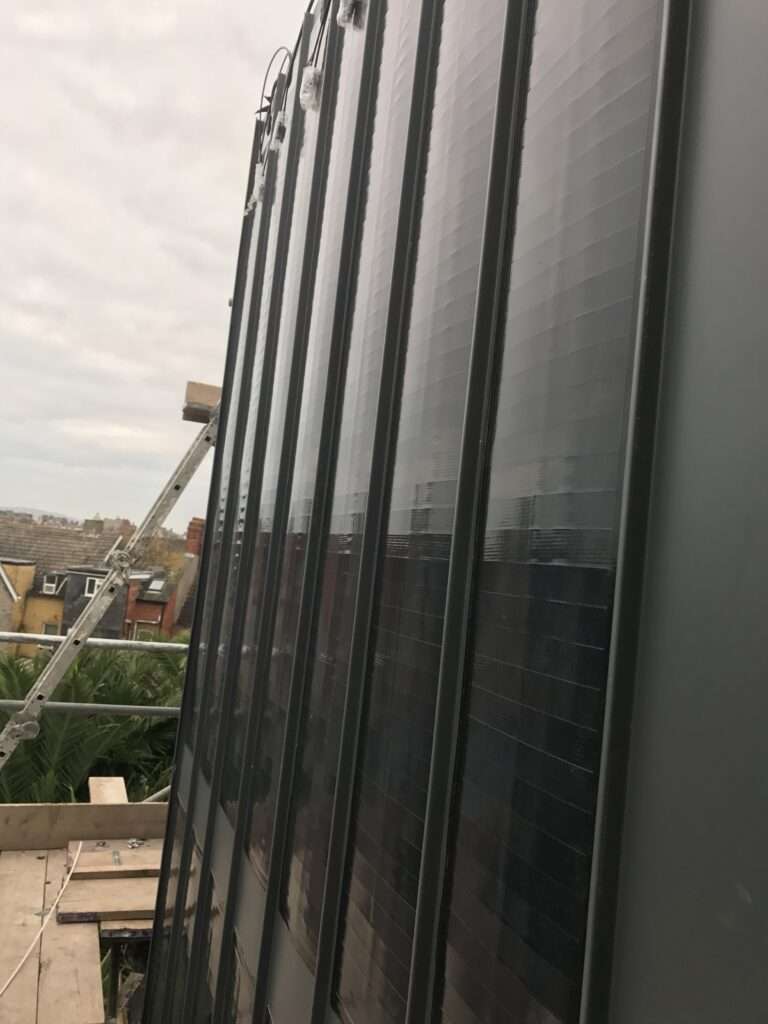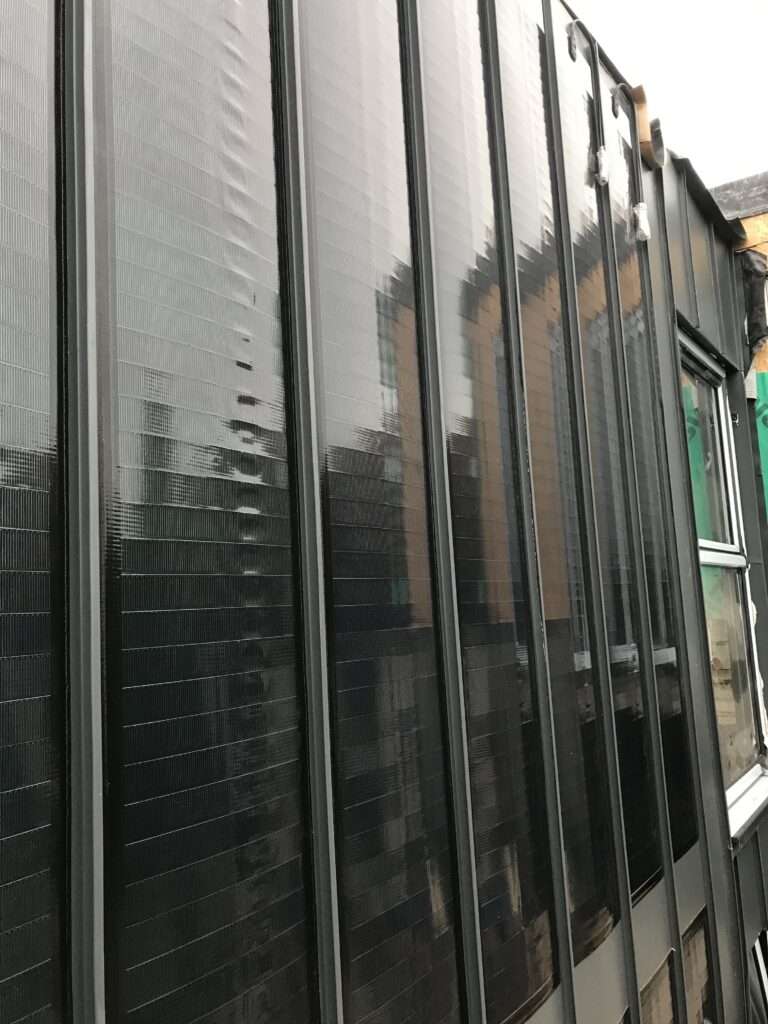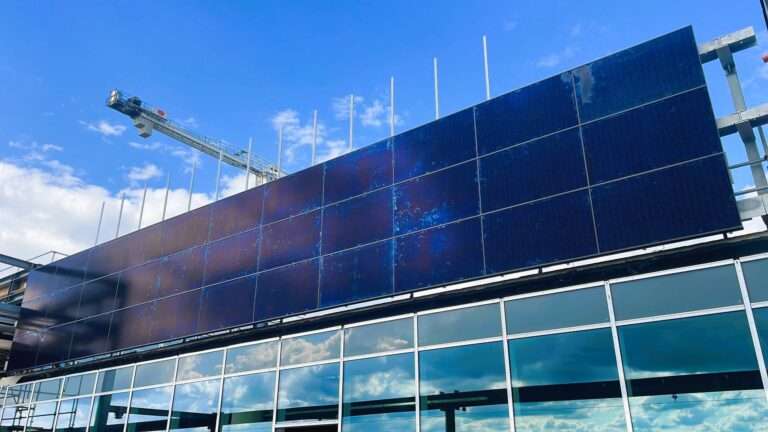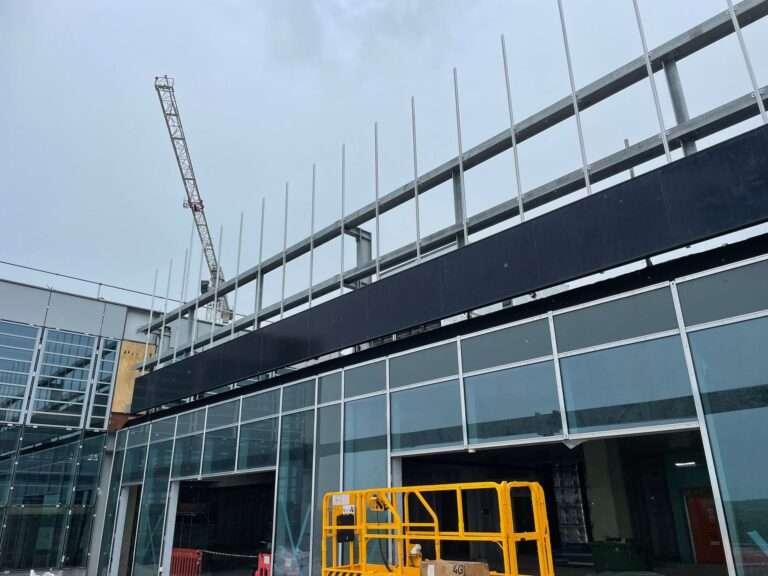Building Integrated Photovoltaics (BIPV)

Maximising Solar Energy with Building integrated Photovoltaics panels for South-Facing Walls
Building Integrated Photovoltaics BIPV are revolutionising the way commercial buildings harness solar energy. When it comes to solar energy, we typically think of rooftop panels. However, many commercial buildings have south-facing walls that receive plenty of sunlight and could be optimised for energy generation. BIPV offers a cutting-edge solution, transforming these unused walls into productive, energy-generating surfaces. This blog explores BIPV’s advantages, and how to maximise your building’s energy potential in three key steps.
Building integrated photovoltaic panels are solar PV panels seamlessly incorporate into a building’s south-facing structure, replacing traditional materials to create energy-producing surfaces. BIPVs can be integrated into various parts of a building, such as:
✅ Windows
✅ Facades
✅ Balustrades
✅ Awnings
✅ Skylights
✅ Roofs
Advantages of Integrated PV panels
Sustainable buildings are a key focus for architects shaping the future of the built environment. Integrated PV panels are rapidly becoming the preferred method for seamlessly incorporating solar PV into architectural designs.
Energy Efficiency:
BIPV solar panels reduce energy costs and can lower HVAC demands by insulating the building.
Environmental Protection:
BIPV solar panel systems protect the building from weather and UV exposure, adding durability.
Aesthetic Appeal:
Unlike traditional solar panels, BIPVs blend with the building’s design for a streamlined look.
Long Lifespan:
BIPV Panel systems are designed to last 25 years or more, making them a long-term investment.

Although integrated photovoltaic panels come with higher initial costs, this can be offset by replacing other building materials and through incentives. For instance, countries like France offer higher feed-in tariffs for fully integrated photovoltaic panel systems, which can increase revenue from electricity generated.
Ongoing research aims to develop BIPV modules that are more efficient, cost-effective, and adaptable. Thin-film solar modules, popular in BIPV, are particularly versatile, as they can be applied to curved surfaces and semi-transparent facades, expanding design options for architects and builders.
ntegrated Photovoltaic panels into Your Design
What is BIPV?
Building Integrated Photovoltaics (BIPV) refers to solar technology integrated directly into a building’s structure, such as facades, walls, windows, or roofing. Unlike conventional solar panels that require mounting, BIPV panels are embedded into the architecture itself, providing a sleek, efficient way to generate energy without compromising design. For south-facing walls, BIPV solar panels turns what was once a passive surface into an active contributor to your building's energy needs.
How Does BIPV Work?
BIPV technology incorporates photovoltaic materials—most commonly silicon—into building materials, including metals like steel, aluminum, stainless steel, and zinc, as well as non-metals such as TPO membranes, polycarbonate, and select plastics.
These materials generate electricity when exposed to sunlight, creating a renewable energy source seamlessly built into the structure. The electricity generated is direct current (DC), which is then converted to alternating current (AC) by an inverter, making it ready for consumption within the building or for export back to the grid.
Difference Between BIPV solar panels and Traditional Solar Panels
Aesthetic Integration:
Traditional solar panels sit on top of existing structures, which can sometimes be visually intrusive. BIPV panels, however, are designed to blend with the building’s architecture, creating a sleek, modern look.
Multi-Functional:
BIPV solar panels serves as both an energy generator and a building material, offering insulation, UV protection, and weatherproofing.
Efficiency:
While rooftop panels may have slight advantages in efficiency, BIPV is highly effective, particularly when positioned on a sun-facing wall.
Market Potential of BIPV
With the growing demand for renewable energy, BIPV integrated PV panels represent a significant market opportunity, especially in urban areas with limited rooftop space. BIPV is expected to become a mainstay in sustainable architecture as businesses and property developers look for aesthetically pleasing ways to meet energy needs.
Major installations like the Copenhagen International School in Denmark, which features over 12,000 BIPV panels, highlight the potential for large-scale BIPV projects that transform entire buildings into power-generating assets.
Lifespan and Efficiency of BIPV
BIPV systems have a similar lifespan to traditional solar panels, typically ranging from 25 to 30 years. The durability of these systems ensures that businesses can enjoy long-term energy savings with minimal maintenance. While efficiency can vary based on factors like material and positioning, south-facing integrated PV Panel installations can yield substantial energy output, making them highly efficient for commercial and industrial applications.

Combine BIPV solar with Battery Energy Storage Solutions (BESS)
Why Battery Storage is Essential
One of the limitations of solar energy is its dependence on sunlight, which means energy production peaks during the day and drops at night. Battery Energy Storage Solutions (BESS) allow you to store surplus energy generated by integrated PV panel systems, providing a continuous power source that can be accessed anytime. This combination optimises energy use, allowing businesses to avoid peak electricity costs and potentially earn revenue by selling excess energy back to the grid.
Advancements in Battery Technology
Recent advancements in battery technology, such as lithium-ion and solid-state batteries, have made storage systems more affordable, efficient, and safer than ever. Newer batteries have higher storage capacities and longer lifespans, which makes them ideal for integration with BIPV solar panel systems in commercial settings. With ongoing research into battery innovation, energy storage systems are expected to become even more reliable and cost-effective.
Advantages of BESS Integration
Energy Independence:
By storing excess solar power, businesses can reduce reliance on the grid and ensure a stable energy supply.
Peak Demand Management:
Stored energy can be used during high-demand periods, helping to reduce costs associated with peak energy prices.
Revenue Potential:
Many regions offer incentives for businesses to export surplus energy to the grid, turning energy production into an additional revenue stream.
Sustainability:
BESS reduces the need for fossil-fuel-based backup power, enhancing your commitment to a low-carbon footprint.
Achieve Energy Independence and Sustainability

Cost Savings and Carbon Reduction
One of the most immediate benefits of combining integrated PV panels with BESS is the reduction in energy costs.
You can significantly reduce or even eliminate electricity bills by generating your power and storing excess for later use. Additionally, by shifting to solar energy, your business reduces carbon emissions, contributing to a cleaner environment.
BIPV systems and battery storage also support corporate sustainability goals by aligning with initiatives for carbon neutrality.
Many businesses today are adopting ESG (Environmental, Social, and Governance) standards, and integrating BIPV with energy storage can be a significant milestone on that path.
Excel Energy: Your Partner in BIPV and BESS Solutions
At Excel Energy, we specialise in designing and deploying customised BIPV and BESS solutions tailored to your business’s unique needs.
Our expert team works closely with clients to assess the best placement, materials, and technology for integrating BIPV into south-facing walls, maximising energy output and aesthetic value.
From initial consultation to installation and maintenance, we provide end-to-end service to help you turn your south-facing walls into powerful energy assets.
The World’s Largest BIPV Installation
One of the most notable BIPV installations to date is the Copenhagen International School, where an impressive 6,000-square-meter facade features over 12,000 custom-designed BIPV panels.
This installation produces approximately half of the school’s annual electricity needs and is a stunning example of solar integration into architectural design.
Its success highlights BIPV’s potential to transform building surfaces into substantial energy sources without compromising aesthetic appeal.
Key Takeaways: The Benefits of BIPV Solar on South-Facing Walls
1. Maximise Your Building's Solar Potential:
Don’t limit solar installations to the rooftop—south-facing walls provide a valuable surface for energy generation.
2. Embrace Aesthetic Solar Solutions:
With integrated pv panels, solar becomes an integral part of your building’s design, offering both energy and architectural value.
3. Enhance Energy Security with BESS:
Store your excess solar power and use it on demand, avoiding peak rates and achieving greater energy autonomy.
4. Reduce Costs and Emissions:
By producing and storing your own solar energy, you cut utility expenses and support a sustainable, low-carbon future.
ready to transform your southerly Facing Walls into energy generators
Your south-facing walls hold immense potential for clean energy generation. Excel Energy specialises in integrated pv panels and BESS solutions that help businesses unlock this potential, delivering high-efficiency, low-maintenance solar energy that integrates seamlessly into your building’s design.
Contact us for a free consultation today and start your journey toward energy independence and a net-zero future!

































